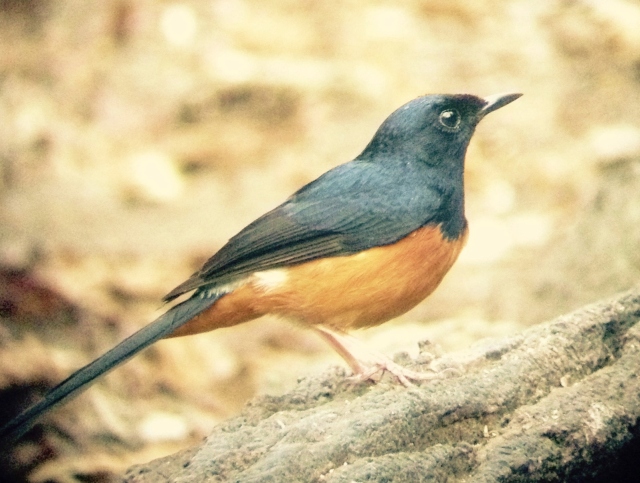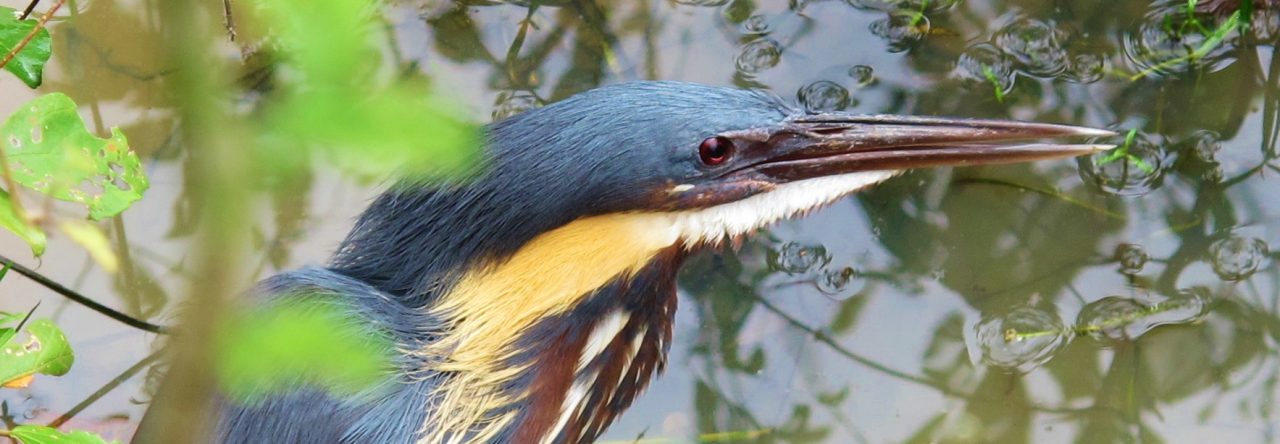
Following a very productive trip to Vietnam in January, I was able to swing a full three weeks in Thailand in February before a return to the world of work and study eventually had to prevail later in the month.
I birded alone for two full weeks in the north, chasing some of the specialities that up until now had eluded me, with visits to familiar locations as well as a handful of new sites.
The third week was spent in the company of my good friend Tim Harrop, who although a very experienced birder, had not visited Asia before. With just five and a half days to play with, and with Tim’s number one target bird being Spoon-billed Sandpiper, we focused on the coastal Laem Pak Bia/Pak Thale area followed by three full days in Kaeng Krachan National Park.

Main sites visited:
Doi Inthanon: Thailand’s highest mountain is a staple fixture on the North Thailand birding circuit, with several species found here that can be seen nowhere else in the country. My two main “gaps” from here are Black-tailed Crake and Yellow-bellied Flowerpecker, both of which I failed to see yet again. As usual, the crake was heard calling at the campsite marsh in the late afternoon, but stayed resolutely hidden in the vegetation, while the flowerpecker was widely reported by other birders but failed to show for me. However, the summit marsh delivered ample compensation in the form of a fine Chestnut Thrush.
Lifer: Chestnut Thrush. Thailand tick: Yellow-browed Tit. Other highlights: Dark-sided Thrush, Rufous-throated Partridge, White-headed Bulbul, Pygmy Wren-babbler.

Doi Lo rice paddies: This lowland area between Doi Inthanon and Chiang Mai has only recently been “discovered” by birders. It’s just a few minutes from Highway 108, making a convenient stop on the way between Chiang Mai and Doi Inthanon. Like many similar sites in Thailand, Doi Lo is absolutely bursting at the seams with lowland birds, making for some easy and enjoyable birding. The best birds during my two visits were the wintering Eastern Imperial Eagle and an Asian Golden Weaver, which although in non-breeding plumage was quite distinctive with its thick, heavy bill, quite bright yellow plumage tones, and prominent supercilium.
Lifer: Asian Golden Weaver. Thailand ticks: Eastern Imperial Eagle, Black-eared Kite, Pied Harrier, Common Kestrel, Chestnut-tailed Starling, Green Sandpiper. Other highlights: Ruddy-breasted Crake, Rufous-winged Buzzard.

Mae Ping: The dry deciduous forest here contains several specialities, including White-bellied Woodpecker and Neglected Nuthatch, although curiously it lacks some of the birds found in similar habitat in Cambodia (eg. White-browed Fantail and Brown Prinia). Much less visited than other sites in the north, this large national park is well worth an early morning, although it can become rather hot and birdless by late morning.
Thailand ticks: Yellow-footed Green Pigeon, Black Baza, White-bellied Woodpecker, Neglected Nuthatch, Two-barred Warbler. Other highlights: Grey-headed Parakeet, Black-headed Woodpecker, Red-billed Blue Magpie.

Doi Angkhang: This has for a long time been my favorite mountain site in the north. Nowadays, it is sometimes overlooked by birders in favor of neighboring Doi Lang. However, this winter, Angkhang has really been producing the birds, with high daily species counts and good levels of bird activity virtually all day. The draw for many is the regular and confiding Rusty-naped Pitta at the Royal Project, but my personal highlight was a superb male Grey-winged Blackbird.
Lifers: Grey-winged Blackbird, Large Hawk Cuckoo, Buff-throated Warbler, Chestnut-headed Tesia. Other highlights: Grey-sided Thrush, Black-breasted Thrush, Rusty-naped Pitta, White-browed Laughingthrush, Scarlet-faced Liocichla, Daurian Redstart.

Doi Lang: I spent two days on the west side (approached from Fang), and one day on the more difficult east side (approached from Tha Ton). The Fang side is easily accessible in any kind of vehicle, but the road up the east side of the mountain is in very poor condition, and not accessible by ordinary saloon car or minivan (you must either have a 4×4, or do as I did and rent a motorcycle for the day in Tha Ton). It is currently forbidden to complete the full loop in a vehicle, although I was allowed to proceed on foot past the top checkpoints on both the east and west sides of the mountain – birders with plenty of time and energy could presumably walk all the way around the loop.
Lifers: Crimson-breasted Woodpecker, White-bellied Redstart, Grey-crowned Warbler. Thailand ticks: Whiskered Yuhina, Black-throated Tit. Other highlights: Giant Nuthatch, Spot-breasted Parrotbill, Grey-headed Parrotbill, Black-eared Shrike-Babbler, Ultramarine Flycatcher, Sapphire Flycatcher, Crested Bunting.

Chiang Saen Lake: This is Thailand’s most famous site for wintering ducks, and a number of rarities get found here every year. I was very fortunate to relocate the wintering male Baer’s Pochard after it had been absent for several weeks – this bird was subsequently seen by a number of observers and could fairly reliably be found in the company of around 40 Ferruginous Ducks on the south side of the lake. I found a pale-phase Booted Eagle in the same area, while a male Western Marsh Harrier in the roost at Wat Pa Mak No was also a very noteworthy Thai rarity.
Lifers: Pallas’s Grasshopper Warbler, Grey-headed Swamphen. Thailand ticks: Baer’s Pochard, Common Pochard, Ferruginous Duck, Northern Pintail, Eurasian Teal, Indian Spot-billed Duck, Garganey, Eurasian Coot, Western Marsh Harrier, Booted Eagle, Striated Grassbird.

Nam Kham Nature Reserve: This small reserve near Chiang Saen is famous for hosting Thailand’s first Firethroat, a male which is currently in residence for its second winter. The bird occasionally appears in front of the Cettia hide to bathe at a small pool – 9.00am seems to be a good time, but equally it is possible for it to fail to make an appearance all day. I was lucky, and the Firethroat emerged on cue for a 10-second showing at 8.55am. Nam Kham reserve contains a maze of paths through the reedbeds, and it is easy to get lost or disorientated – best arrive at the site very early to make sure you locate the correct hide by 9.00am!
There are plenty of other birds to see here in the early morning, and with luck and patience a number of secretive reedbed specialists may be seen.
Lifers: Firethroat, Baikal Bush Warbler. Thailand tick: Paddyfield Warbler. Other highlights: Red Avadavat, Spotted Redshank.

Doi Phu Ka: This is a seldom-visited mountain in Nan province, famous for a small population of Beautiful Nuthatch, and several other species that cannot usually be found elsewhere in Thailand. I found birding here to be hard going, and only late on my second morning did I finally discover a trail leading into good high altitude forest, but I ended up seeing virtually none of the site’s specialities.
The traditional route up the mountain, a trail starting behind the shrine opposite the star-gazing area, seems to be completely overgrown, with a high risk of getting lost for birders without a GPS. A better option seems to be the trail starting on the roadside at Km 29.7, which climbs up into some good forest where Beautiful Nuthatch should be a possibility.
The roadside itself from Km 28-33 could also turn up some good species, although bird activity generally seemed rather low during my visit. I also spent some time on the trail leading into the forest from the top of the pass, at the high point of the road – this forest contains plenty of huge, old trees, seemingly suitable habitat for Beautiful Nuthatch and other forest species such as Green and Purple Cochoas. However, birding here was extremely difficult, with loud, crunchy leaves underfoot making quiet walking impossible, and the sheer size of the trees making it very hard to locate birds.
In general, Doi Phu Ka didn’t repay my investment in time and effort to get there – I got the feeling that a lot of time would be needed to get the most from this site.
Lifer: Indochinese Yuhina. Other highlights: White-browed Piculet, Crested Finchbill, Bianchi’s Warbler, Sulphur-breasted Warbler, White-gorgeted Flycatcher, Small Niltava.

Pak Thale/Laem Pak Bia area: The whole coastal strip from Wat Khao Takrao in the north to Laem Pak Bia in the south contains a fantastic range of wetland, farmland, and coastal habitats – the area scarcely needs any introduction as it is world famous for being the favored wintering location for a small number of Spoon-billed Sandpipers, as well as upwards of 40 other shorebird species.
As well as focusing on the well-known locations of Pak Thale, the King’s Project, the “abandoned building” wetlands, and the Laem Pak Bia sandspit, we also visited farmland and grassland inland from Pak Thale, Wat Khao Takrao, and the Nong Pla Lai rice paddies, seeing a total of 132 bird species in the area in two days.
Lifer: Slaty-breasted Rail. Thailand ticks: Far Eastern Curlew, Heuglin’s Gull, Oriental Darter, Black-headed Ibis, Greater Spotted Eagle. Other highlights: Chinese Egret, Booted Eagle, White-faced Plover, Malaysian Plover, Nordmann’s Greenshank, Great Knot, Spoon-billed Sandpiper, Asian Dowitcher, Red-necked Phalarope, Brown Hawk Owl, Indian Nightjar, Asian Golden Weaver, Chestnut Munia.

Kaeng Krachan National Park: Probably Thailand’s best overall birding location, this huge national park forms part of one of south-east Asia’s largest continuous forested areas. Its strategic location in the middle of Thailand means that birds from both north and south Thailand can be found here, meaning a very high species total is possible.
In addition to the birds, mammals are a feature of the park, with White-handed Gibbon, Dusky Langur, Asian Elephant, Serow, Crab-eating Mongoose, Black Giant Squirrel, Asian Porcupine, Yellow-throated Marten, and even Leopard among the species regularly seen. During our visit, a Malayan Sun Bear was occasionally visiting the back of the Ban Krang restaurant for food scraps, but unfortunately we weren’t lucky enough to see it despite spending several hours waiting for it on consecutive evenings.
In three full days we recorded 155 species of birds inside the park gates, with another 10 or so recorded outside the gates at our accommodation at Ban Maka, and at the Lung Sin waterhole. Booking a spot in the hide at the latter site can be done through Ban Maka, and is highly recommended for close views of some normally tricky customers such as Bar-backed and Scaly-breasted Partridges, Lesser and Greater Necklaced Laughingthrushes, and for the lucky few – including us! – perhaps a visit from a Slaty-legged or Red-legged Crake. It’s also a great spot to observe and photograph mammals, for example Mouse Deer and Muntjac.
Lifers: Asian Emerald Cuckoo, Moustached Hawk Cuckoo. Thailand ticks: Blue Pitta, Black Bittern, Mountain Hawk Eagle, Pacific Swift, Rufous-browed Flycatcher, Blue-and-White Flycatcher, Chinese Blue Flycatcher, Hainan Blue Flycatcher, Slaty-legged Crake. Other highlights: Violet Cuckoo, Crested Jay, Black-and-Yellow Broadbill, Black-and-Red Broadbill, Silver-breasted Broadbill, Long-tailed Broadbill, Common Green Magpie, Kalij Pheasant, Bar-backed Partridge, Besra, Black-thighed Falconet, Little Cuckoo-Dove, Red-billed Malkoha, Brown-backed Needletail, Red-headed Trogon, Orange-breasted Trogon, Bamboo Woodpecker, Grey-and-Buff Woodpecker, Collared Babbler, Great Hornbill, Red-bearded Bee-eater, Alstrom’s Warbler, Orange-headed Thrush, Black-throated Laughingthrush, Golden-crested Myna.

Notable records from other sites: Spot-winged Starling – five at a flowering tree in Mae Rim, near Chiang Mai. Chestnut-eared Bunting – two at Fang rice paddies. River Lapwing, Small Pratincole – on the Mekong River near Chiang Khong. Bluethroat, Citrine Wagtail – Tha Ton rice paddies.
Trip Total: 444. World Life List: 2,115. Thailand Life List: 625. 2016 World Year List: 713.



I was there with you at Lung sin’s on the 25th. also got some nice shots of the Slaty-
Legged Crake. What a bird! You can check my shots on my Flickr account, thaibirdman13@flickr
LikeLike
Lovely photos, that Green Magpie is just brilliant …. and I still need Grey Peacock-Pheasant, I must go to Mae Wong sometime! Cheers.
LikeLike